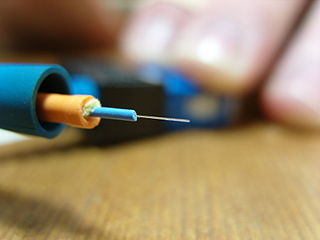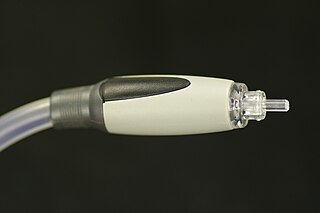Related Research Articles

In computer networking, Fast Ethernet physical layers carry traffic at the nominal rate of 100 Mbit/s. The prior Ethernet speed was 10 Mbit/s. Of the Fast Ethernet physical layers, 100BASE-TX is by far the most common.

In computer networking, Gigabit Ethernet is the term applied to transmitting Ethernet frames at a rate of a gigabit per second. The most popular variant, 1000BASE-T, is defined by the IEEE 802.3ab standard. It came into use in 1999, and has replaced Fast Ethernet in wired local networks due to its considerable speed improvement over Fast Ethernet, as well as its use of cables and equipment that are widely available, economical, and similar to previous standards. The first standard for faster 10 Gigabit Ethernet was approved in 2002.
In the seven-layer OSI model of computer networking, the physical layer or layer 1 is the first and lowest layer: the layer most closely associated with the physical connection between devices. The physical layer provides an electrical, mechanical, and procedural interface to the transmission medium. The shapes and properties of the electrical connectors, the frequencies to transmit on, the line code to use and similar low-level parameters, are specified by the physical layer.

In fiber-optic communications, wavelength-division multiplexing (WDM) is a technology which multiplexes a number of optical carrier signals onto a single optical fiber by using different wavelengths of laser light. This technique enables bidirectional communications over a single strand of fiber as well as multiplication of capacity.

InfiniBand (IB) is a computer networking communications standard used in high-performance computing that features very high throughput and very low latency. It is used for data interconnect both among and within computers. InfiniBand is also used as either a direct or switched interconnect between servers and storage systems, as well as an interconnect between storage systems. It is designed to be scalable and uses a switched fabric network topology. Between 2014 and June 2016, it was the most commonly used interconnect in the TOP500 list of supercomputers.

HIPPI, short for High Performance Parallel Interface, is a computer bus for the attachment of high speed storage devices to supercomputers, in a point-to-point link. It was popular in the late 1980s and into the mid-to-late 1990s, but has since been replaced by ever-faster standard interfaces like Fibre Channel and 10 Gigabit Ethernet.

In telecommunication and data transmission, serial communication is the process of sending data one bit at a time, sequentially, over a communication channel or computer bus. This is in contrast to parallel communication, where several bits are sent as a whole, on a link with several parallel channels.

Small Form-factor Pluggable (SFP) is a compact, hot-pluggable network interface module format used for both telecommunication and data communications applications. An SFP interface on networking hardware is a modular slot for a media-specific transceiver, such as for a fiber-optic cable or a copper cable. The advantage of using SFPs compared to fixed interfaces is that individual ports can be equipped with different types of transceivers as required, with the majority including optical line terminals, network cards, switches and routers.

A passive optical network (PON) is a fiber-optic telecommunications network that uses only unpowered devices to carry signals, as opposed to electronic equipment. In practice, PONs are typically used for the last mile between Internet service providers (ISP) and their customers. In this use, a PON has a point-to-multipoint topology in which an ISP uses a single device to serve many end-user sites using a system such as 10G-PON or GPON. In this one-to-many topology, a single fiber serving many sites branches into multiple fibers through a passive splitter, and those fibers can each serve multiple sites through further splitters. The light from the ISP is divided through the splitters to reach all the customer sites, and light from the customer sites is combined into the single fiber. Many fiber ISPs prefer this system.

Multi-mode optical fiber is a type of optical fiber mostly used for communication over short distances, such as within a building or on a campus. Multi-mode links can be used for data rates up to 800 Gbit/s. Multi-mode fiber has a fairly large core diameter that enables multiple light modes to be propagated and limits the maximum length of a transmission link because of modal dispersion. The standard G.651.1 defines the most widely used forms of multi-mode optical fiber.

IEEE Standard 1355-1995, IEC 14575, or ISO 14575 is a data communications standard for Heterogeneous Interconnect (HIC).
An optical link is a telecommunications link that consists of a single end-to-end optical circuit. A cable of optical fibers, possibly concatenated into a dark fiber link, is the simplest form of an optical link.

Fiber-optic communication is a method of transmitting information from one place to another by sending pulses of infrared or visible light through an optical fiber. The light is a form of carrier wave that is modulated to carry information. Fiber is preferred over electrical cabling when high bandwidth, long distance, or immunity to electromagnetic interference is required. This type of communication can transmit voice, video, and telemetry through local area networks or across long distances.
40 Gigabit Ethernet (40GbE) and 100 Gigabit Ethernet (100GbE) are groups of computer networking technologies for transmitting Ethernet frames at rates of 40 and 100 gigabits per second (Gbit/s), respectively. These technologies offer significantly higher speeds than 10 Gigabit Ethernet. The technology was first defined by the IEEE 802.3ba-2010 standard and later by the 802.3bg-2011, 802.3bj-2014, 802.3bm-2015, and 802.3cd-2018 standards. The first succeeding Terabit Ethernet specifications were approved in 2017.

A fiber media converter is a simple networking device that makes it possible to connect two dissimilar media types such as twisted pair with fiber optic cabling. They were introduced to the industry in the 1990s, and are important in interconnecting fiber optic cabling-based systems with existing copper-based structured cabling systems. They are also used in metropolitan area network (MAN) access and data transport services to enterprise customers.

IPtronics was a fabless semiconductor company headquartered in Copenhagen, Denmark. Its products include integrated circuits for parallel optical interconnect applications intended for the computer, storage and communication industries. IPtronics' design center is certified by STMicroelectronics, which is also their semiconductor foundry partner. In June 2013, IPtronics was acquired by Mellanox Technologies.

Active cables are copper cables used for data transmission that use an electronic circuit to boost their performance. Without an electronic circuit, a cable is considered passive. Unlike passive cables, which can suffer from data degradation due to issues such as attenuation, crosstalk, and group velocity distortion, active cables contain one or more integrated circuits to address these problems. This active boosting allows cables to be more compact, thinner, and longer, and to transmit data faster than passive cables.

10 Gigabit Ethernet is a group of computer networking technologies for transmitting Ethernet frames at a rate of 10 gigabits per second. It was first defined by the IEEE 802.3ae-2002 standard. Unlike previous Ethernet standards, 10GbE defines only full-duplex point-to-point links which are generally connected by network switches; shared-medium CSMA/CD operation has not been carried over from the previous generations of Ethernet standards so half-duplex operation and repeater hubs do not exist in 10GbE. The first standard for faster 100 Gigabit Ethernet links was approved in 2010.

TOSLINK is a standardized optical fiber connector system. Generically known as optical audio, the most common use of the TOSLINK optical fiber connector is in consumer audio equipment in which the digital optical socket carries (transmits) a stream of digital audio signals from audio equipment to an AV receiver that can decode two channels of uncompressed, pulse-code modulated (PCM) audio; or decode compressed 5.1/7.1 surround sound audio signals, such as Dolby Digital and DTS. Unlike an HDMI connector cable, a TOSLINK optical fiber connector does not possess the bandwidth capacity to carry the uncompressed audio signals of Dolby TrueHD and of DTS-HD Master Audio; nor carry more than two channels of PCM audio.
An optical module is a typically hot-pluggable optical transceiver used in high-bandwidth data communications applications. Optical modules typically have an electrical interface on the side that connects to the inside of the system and an optical interface on the side that connects to the outside world through a fiber optic cable. The form factor and electrical interface are often specified by an interested group using a multi-source agreement (MSA). Optical modules can either plug into a front panel socket or an on-board socket. Sometimes the optical module is replaced by an electrical interface module that implements either an active or passive electrical connection to the outside world. A large industry supports the manufacturing and use of optical modules.
References
- ↑ Bek, Jesper (2008-06-09). "Parallel Optical Interconnects". IPtronics. Archived from the original on 2011-03-05. Retrieved 2010-04-09.
- ↑ Bek, Jesper (2009-08-05). "IPtronics fuels Active Optical Cable implementation in the Data Center". IPtronics. Archived from the original on 2011-07-13. Retrieved 2010-11-17.
- ↑ "100GE Optical Transceivers". 1000gig. Retrieved 2017-06-20.